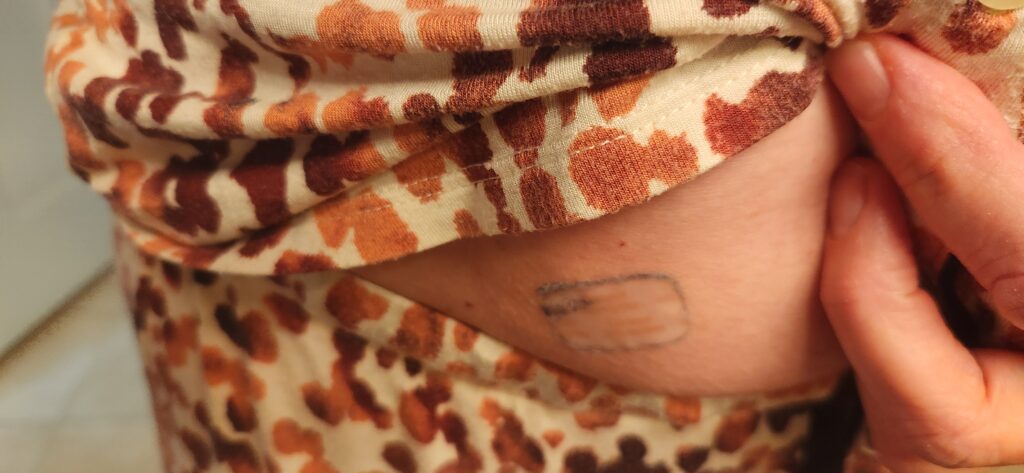Systemic estrogen refers to estrogen that will get into a woman’s blood stream and affect her entire body, so it can treat hot flashes, night sweats, prevent osteoporosis, and treat premature menopause (menopause before age 40). Menopausal hormones are FDA-approved to treat moderate to severe vasomotor symptoms (hot flashes and night sweats) and are recommended by The Menopause Society (formerly North American Menopause Society) as first-line therapy for treatment if a woman wants to use hormones and doesn’t have any contraindications.
Local estrogen therapy refers to estrogen used vaginally to treat genitourinary symptoms such as vaginal dryness, painful sex, and bladder symptoms and is discussed in this post: https://healthiermenopause.com/genitourinary-syndrome-of-menopause-whats-up-down-there/
WHAT DOES ESTROGEN DO?
Estrogen is the main hormone to replace in menopause to improve bothersome vasomotor symptoms. Around menopause, our ovarian estrogen production declines and stops. Estradiol is the primary and potent estrogen of our premenopausal years. Replacing estradiol improves hot flashes and night sweats and may improve other symptoms like joint aches/pain, poor sleep, mood, brain fog, to name a few. Estrogen also stimulates the lining of the uterus to grow, so if a woman has a uterus, she must also supplement with a progestogen like progesterone to keep the uterine lining from growing a uterine cancer. If you have had a hysterectomy, then you don’t need a progestogen. Estrogen therapy is not for everyone, as it can increase the risk of blood clots, stroke, and heart attack in some individuals, but for most women, these risks will remain low. No increase in breast cancer was seen in the Women’s Health Initiative study in women taking estrogen alone. For women taking estrogen plus a progestogen, there was a less than 1/1000 risk per year.

If you are 50-59 or younger or newly menopausal, your risk of blood clots and other complications from estrogen therapy will be low. Using oral estradiol is associated with a higher risk of blood clots and other complications because higher doses are required due to the metabolism of the medication by the liver and the production of proteins that increase our clotting risk. Using a transdermal (absorbed through the skin) or vaginal estrogen does not appear to be associated with an increased risk of blood clots which is why most gynecologists prefer to initiate hormone therapy with an estradiol patch, gel, spray, or even a vaginal ring. Using an estrogen such as estradiol that our body makes naturally is also preferred because it is more body identical than conjugated estrogens (isolated from pregnant mare urine but can also be made synthetically) or ethinyl estradiol which is the type of estrogen in most birth control pills.
WHAT TYPE OF HORMONES SHOULD I TRY?
In my practice, I generally prescribe an estradiol patch to start hormone therapy, plus a micronized progesterone capsule to protect the uterus unless my patient has had a hysterectomy. Other options for uterine protection include a levonorgestrel IUD (intrauterine device) or another oral progestogen. Vaginal progesterone may also be used but hasn’t been as well studied. Compounded (i.e. non-FDA approved and made in a compounding pharmacy) progesterone creams have not been adequately studied to see if they protect the uterine lining.
Please, whatever you do, don’t order random hormonal creams and preparations off Amazon!
Patches can be changed once weekly or twice weekly, but I prefer the twice weekly patches because they are smaller in size. Some of the weekly patches can be quite large and a little thicker or foamlike—I joke with women they may feel like they are wearing a bullseye or a target! Both patches come in a generic which may be more affordable for some. I use a patch myself, and I don’t love the adhesive and occasionally the patch will start to lift at an edge, but I use them because I think it’s a safer option than oral estradiol. Sometimes I feel like a kid that keeps using Band-Aids and never wipes off the adhesive residue!

Topical estradiol in gel or spray form is available too but must be applied daily and tend to be more expensive than a patch for some patients. One of the daily estradiol gels does now have a generic alternative recently approved by the FDA. Another cool option is an estradiol acetate ring (Femring) that is placed in the vagina and changed every 90 days. This is not to be confused with the other vaginal ring, Estring, that is low dose and used only for local treatment.
Now, sometimes a woman just can’t use a transdermal or can’t afford non-oral options. I have some women who take oral estradiol and do quite well with it. Provided they don’t have other risk factors I’m concerned about, then I will prescribe it. The risk of blood clots will still be lower, in the 1-2/1000 women per year range.
WHAT CAN I EXPECT AFTER STARTING HORMONES?
A woman may notice improvement in her symptoms within the first couple of weeks, but I like to give treatment a full 2-3 months before changing doses. There are exceptions, of course. If we start at an extremely low dose and don’t see much of a benefit, it’s reasonable to titrate up more quickly. I don’t usually hear about a ton of side effects, but a woman could experience some bloating, breast tenderness, or bleeding. Bleeding can occur in the first 4-6 months of use. I never want to miss uterine precancer or cancer, so if my patient has postmenopausal bleeding at any time, then I have them come into the office for a pelvic ultrasound to measure the thickness of their endometrium (uterine lining).
This post is for information purposes and is not medical advice! You should seek care from your physician to discuss your symptoms and treatment options!

